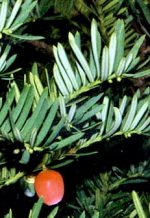 Also called spreading yew, this evergreen tree or large shrub is native to Japan, Korea, and China. It has scaly reddish brown bark and can grow up to 50’ tall but is usually 10-25’ in the garden. The flat, needle like leaves are .5-1” long, spine-tipped, and arranged in two flat rows on either side of the stem. They are usually dark green but may become yellow or reddish brown in winter. Male and female reproductive structures appear on different trees in early spring and are followed by berry-like fruits made up of a single seed surrounded by a fleshy red modified scale. All parts of the tree except the berry are toxic. Japanese yew is used for foundation plantings, hedges, screen, topiary and bonsai, but has escaped from cultivation, naturalized in minimally managed areas, and is considered invasive in New York, New England, Ohio, and Kentucky. Several cultivars are available. The genus name, Taxus, is the Latin name for the tree. The specific epithet, cuspidata, comes from the Latin word cuspis meaning point or tip and refers to the leaves.
Also called spreading yew, this evergreen tree or large shrub is native to Japan, Korea, and China. It has scaly reddish brown bark and can grow up to 50’ tall but is usually 10-25’ in the garden. The flat, needle like leaves are .5-1” long, spine-tipped, and arranged in two flat rows on either side of the stem. They are usually dark green but may become yellow or reddish brown in winter. Male and female reproductive structures appear on different trees in early spring and are followed by berry-like fruits made up of a single seed surrounded by a fleshy red modified scale. All parts of the tree except the berry are toxic. Japanese yew is used for foundation plantings, hedges, screen, topiary and bonsai, but has escaped from cultivation, naturalized in minimally managed areas, and is considered invasive in New York, New England, Ohio, and Kentucky. Several cultivars are available. The genus name, Taxus, is the Latin name for the tree. The specific epithet, cuspidata, comes from the Latin word cuspis meaning point or tip and refers to the leaves.
Type: Evergreen shrub or tree
Outstanding Feature: Foliage
Form: Pyramidal
Growth Rate: Slow
Bloom: No flowers
Size: 10-50’ H x 10-50’ W
Light: Full sun to part shade
Soil: Average, medium moist, well-drained, slightly acidic
Hardiness: Zones 4-7
Care: Prune to maintain shape or size; pruning can be done at any time but is best performed in spring.
Pests and Diseases: None of significance
Propagation: Seed, cuttings
Cultivars:
‘Aurescens’ (very slow-growing; young foliage bright yellow)
‘Dwarf Bright Gold”
‘Capitata’ (broadly pyramidal; needles tend toward bronze in winter)
‘Columnaris’ (Narrow, faster growing, good color all year)
‘Expansa’ (Broader than tall; vase-shaped)
‘Nana’ (Broader than tall; very slow growing, good color all year)
Comments: Pollution tolerant